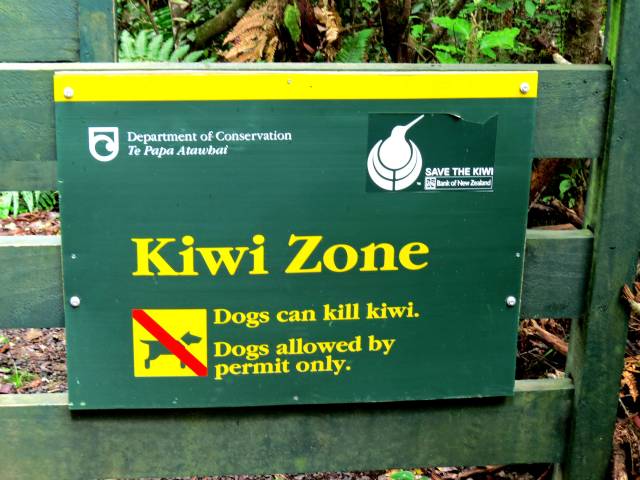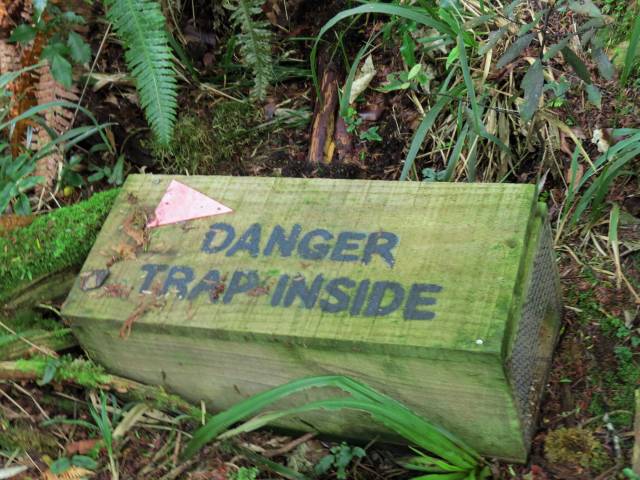Over increasingly large areas of the United States, spring now comes unheralded by the return of the birds, and the early mornings are strangely silent where once they were filled with the beauty of bird song.
Rachel Carson
This was true in Rachel Carson’s United States after people annihilated bird populations with DDT and other pesticides meant to protect us from pests. New Zealand’s birds have been silenced by another human behavior: bringing the world of pests with us when we travel.

Takahe on Kapiti Island. The North Island takahe went extinct. The South Island takahe seen here was thought to be extinct until a small population was discovered.
New Zealand floated alone in the Pacific for 80+ million years, far away from Australia, Tonga, Fiji. Like a person spending a lot of time alone, it developed some interesting features. In the beginning, there were only birds, and perhaps a bat species or two. No mammals at all to scavenge nutritious eggs and snatch fledglings. The birds didn’t need to go far, so flight fell by the wayside for some birds, and others are weak fliers.Giant moas grew to 8 feet tall at the shoulder; their only predator, the Haast’s eagle, weighed 30+ lbs.
And then it all changed 800 some years ago when the Maori arrived hungry, and accompanied by kiore, Polynesian rats. Then came stoats, cats, wasps, goats, deer, sheep, cows, dogs, red tailed oppossums, ship rats, Norway rats and so on. Man is often called the worst pest because we hunt animals to extinction, burn down forests for pasture and farmland, and point skyward to justify our destruction.
Today, we continue to bring pests, some too small to be seen. On my recent trip to New Zealand, we were scrubbing and disinfecting shoes to prevent the spread of kauri dieback disease, a fungus. Then, we were picking through packs for plant material and small rodents before going to Kapiti Island sanctuary. 

Around the world, concern about vanishing nature has occurred in waves throughout history. We’re at a sort of end time in some places like New Zealand, where it’s an all-out war on pests to keep what’s left alive. Sanctuaries are established offshore or behind fences, and then pests are poisoned, shot, trapped, lured to their deaths with Judas animals. The Goat Musterer has removed 20,000+ feral goats for food use. There are still a lot to go.

It’s not a pretty approach, and intolerable to people with softer sensibilities living in sprawling countries like America. We think there’s enough space, another way to do this. On the other side, some folks believe wiping out the indigenous flora, fauna (and sometimes people that were not considered to be such) is evidence of humans’ entitled dominion over the earth. On the other side, some believe we deserve Zika, Ebola, terrible influenzas.
I believe in balance.
In New Zealand, I found it strange to be in lush native bush with no birdsong. Protected sanctuaries immediately stand out for the melodic songs of tui and bellbirds. It’s taken years to bring them back, and constant vigilance to keep them that way, free of pests that overwhelm birds with no ability to adapt. People can live among the wild peacably:the Barrett family of Kapiti Island, holdouts who refused to sell their land for a sanctuary, are perfect examples of this.
When I came home to my postage stamp of a restoration project, rich with birdsong, bees, frogs, and butterflies, I realized we don’t have to take a bow and leave. Sixteen years ago, I moved in to acres of invasive foreign grass on a horse property barren of life. Sixteen years later, I come home to a wildlife sanctuary. If we have courage, it can work.











